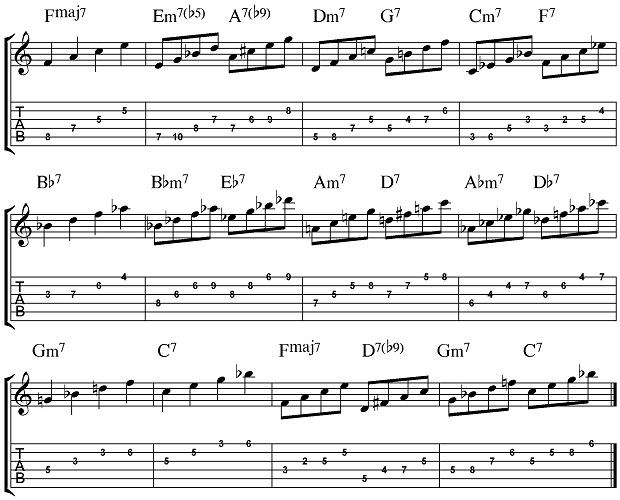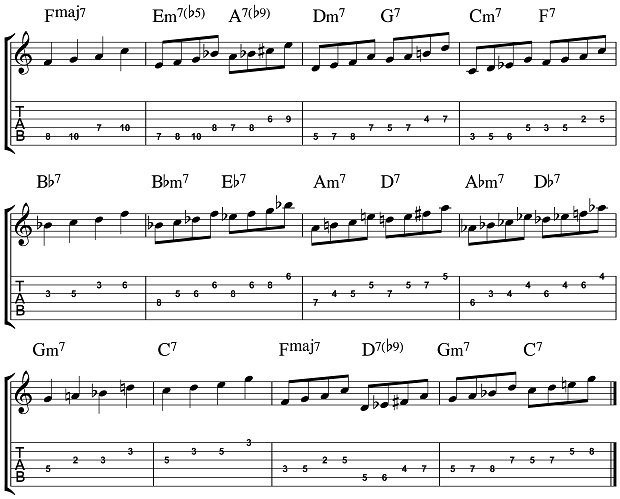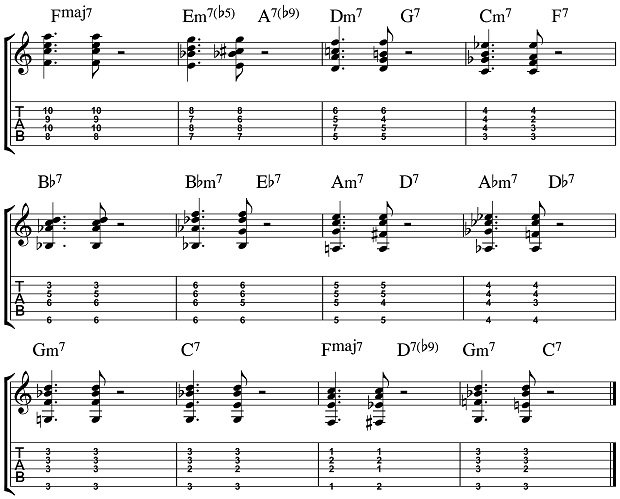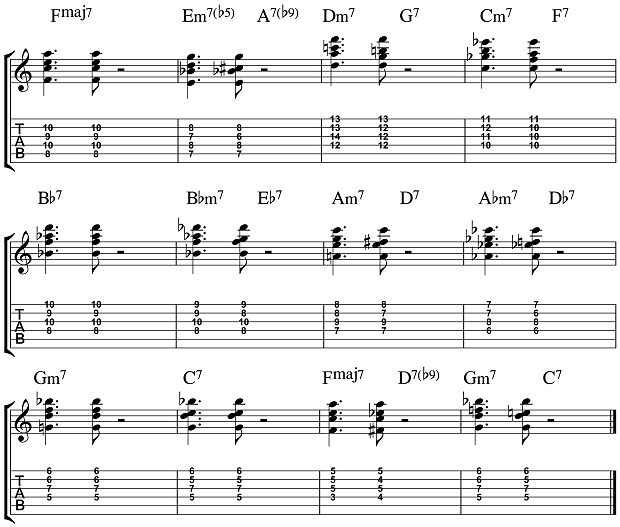Jazz Guitar Corner: The Importance of the Bird Blues Chord Progression
Expand your knowledge of the neck by soloing and comping through a Bird Blues.

For guitarists of any background or experience level, learning how to play jazz guitar means working through different types of standard tunes and forms, such as major blues, minor blues and rhythm changes.
Though it is less common than its major and minor cousins, the Bird Blues chord progression, most notably demonstrated in the Charlie Parker tune “Blues for Alice,” is a tricky and important chord progression for any jazz guitarist to explore in the practice room.
Featuring two chords in almost every bar, as well as a mixture of major and minor key ii-V progressions, the Bird Blues has the tendency to handcuff even experienced players when it comes to outlining these changes from a soloing or comping standpoint.
In today’s lesson, we’re going to look at two different ways you can practice soloing and comping through a Bird Blues in order to expand your knowledge of the neck, and get these changes under your fingers at the same time.
Let’s begin by looking at using arpeggio and 1235 outlines to solo over Bird Blues chord changes on the guitar.
Arpeggio Outlines
There are many ways you can practice outlining the changes to a Bird Blues, but one of the most fundamental and important to get under your fingers are arpeggios. Since the chords move by so quickly in a Bird Blues, it’s a good idea to start by working through one-octave arpeggios, as you can see in the example below.
When practicing these arpeggios, you can start on any Fmaj7 fingering that you want, but from there, try to move to the closest next chord in order to allow you to smoothly and easily transition from one chord to the next when you take these arpeggios to a jam or on the band stand and begin to create solos with them.
In the example below, I wrote out each one-octave arpeggio through a Bird Blues progression with each arpeggio ascending, starting from the lowest note and moving to the highest note in each chord. Once you have this example under your fingers, try the following variations in order to give you some variety when practicing and soloing with these important fingerings.
- Play all arpeggios ascending
- Play all arpeggios descending
- Play the first arpeggio ascending then the second descending
- Play the first arpeggio descending then the second ascending
As well as working these arpeggios from a technical standpoint, once you have them under your fingers, improvise over a Bird Blues and only stick to using arpeggios to build your lines.
This will allow you to outline each chord in the progression without having to rely on larger two-octave arpeggios or scales to do so.

1235 Outlines
If you are looking for a bit of variety when outlining the chord changes to a Bird Blues, you can take a page from the John Coltrane book of arpeggio variations and practice the 1235 intervals for each chord in the progression.
This outline, which Trane used probably most famously in his solo on “Giant Steps,” not only outlines each chord change, but it sounds good and provides a nice melodic shape to your lines when you bring this riff into your solos. Again, start by working out the example below, then exploring the 1235 outline in other parts of the neck, from a strictly technical standpoint.
Then, when you are comfortable, put on a backing track or metronome and improvise over a Bird Blues progression while sticking to only the 1235 outline as the basis for your lines.
After you’ve spent a bit of time on this outline, try soloing over the Bird Blues and alternating between the 1357 arpeggios and the 1235 outline when building your lines, you might be surprised at just how much material you can build with only two melodic approaches in your solos.

Chords On Lower String Groups
As well as practicing soloing over Bird Blues, as guitarists we also need to practice comping through these chord changes on the guitar.
When working on fast-moving and tricky changes such as a Bird Blues, it’s a good idea to use the smallest movements you can between the chords in order to allow you to move quickly between each change, as well as outline the harmony and voice leading in a smooth manner.
In the following example I’ve written out one way to work through the chord changes on the lower string sets, with the lowest notes of the chords on the sixth and fifth strings.
Start by checking out this example in the practice room. Then try and come up with your own comping patterns that use small movements between each chord in order to get that sense of smooth flow between the changes in your comping.

Chords On Upper String Groups
In this next example I’ve written out the chords to a Bird Blues that focuses on keeping each voicing on the higher string sets, with the lowest note of each chord on the fifth and fourth strings. Try working on these voicings in the practice room, then come up with your own upper-string group chords to further expand your Bird Blues comping vocabulary.
Once you have one or more ways of comping through Bird Blues on the low and high string sets under your fingers, try mixing and matching these voicings as you comp through the changes along with a backing track or a metronome to get the most out of these two chord Bird Blues chord studies.

Learning to solo and comp over Bird Blues chord changes is an essential tool for any jazz guitarist to have under their fingers, but it can sometimes seem like a daunting task on a good day.
By focusing on simple melodic outlines, such as arpeggios and the 1235 of each chord, as well as using specific string sets and smooth movement between each chord in your comping, you can learn how to outline this tough progression without having to learn or draw from a ton of melodic-harmonic content in your playing.
What are some of your favorite ways to comp and solo through a Bird Blues? Share your thoughts in the comments section below.
Matt Warnock is the owner of mattwarnockguitar.com, a free website that provides hundreds of lessons and resources designed to help guitarists of all experience levels meet their practice and performance goals. Matt lives in the UK, where he is a senior lecturer at the Leeds College of Music and an examiner for the London College of Music (Registry of Guitar Tutors).
Get The Pick Newsletter
All the latest guitar news, interviews, lessons, reviews, deals and more, direct to your inbox!
Matt Warnock is the owner of mattwarnockguitar.com, a free website that provides hundreds of lessons and resources designed to help guitarists of all experience levels meet their practice and performance goals. Matt lives in the UK, where he teaches Skype guitar students all over the world, and is an examiner for the London College of Music (Registry of Guitar Tutors).









![Joe Bonamassa [left] wears a deep blue suit and polka-dotted shirt and plays his green refin Strat; the late Irish blues legend Rory Gallagher [right] screams and inflicts some punishment on his heavily worn number one Stratocaster.](https://cdn.mos.cms.futurecdn.net/cw28h7UBcTVfTLs7p7eiLe.jpg)
